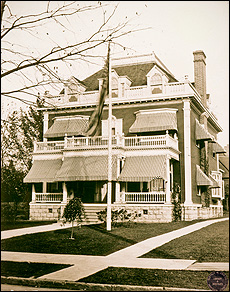Archives
Creating E.B. Green digital library
Class project catalogs photos and data of properties designed by architect
By CHARLES ANZALONE
Contributing Editor
A user-friendly and interactive digital library featuring the Buffalo and Erie County Historical Society’s archival collection of works of renowned architects E.B. Green and William S. Wicks is the latest creation of a UB Library and Information Studies course with a proven track record of providing international access to Western New York research material.

This image of the Phillip G.
Schaefer House, which still stands at 343 Elmwood Ave., Buffalo, and
other E.B. Green-designed houses can be found online at the E.B. Green
Digital Collection.
PHOTO: COURTESY OF RESEARCH LIBRARY, BUFFALO
AND ERIE COUNTY HISTORICAL SOCIETY
Students in the course, taught by June M. Abbas, an associate professor in the Department of Library and Information Studies, Graduate School of Education, unveiled the digital library last week.
This digital library catalogs and organizes the extensive photography and data of more than 150 commercial and residential private properties, many of which still stand today, designed by Green and his assistant.
“Our primary purpose is to provide global access to these rich resources and heritage of our society,” said Abbas, who has used the digital library teaching model for seven years and whose classes have produced seven projects available to anyone with Internet access.
“Secondarily, the project is for preservation purposes. Many of the collections in museums and libraries are aging and continue to deteriorate with continual use,” she said. “By digitizing an object, you reduce the physical wear and tear on the object.”
The E.B. Green Digital Collection, which features such landmarks as the original building of the Albright-Knox Art Gallery, Main Street's Market Arcade and downtown's gold-domed M&T Bank (formerly Buffalo Savings Bank), was chosen because of the collection’s historical significance to Western New York and architecture studies around the world.
Abbas also selected the historical society’s collection because officials at the Buffalo and Erie County Historical Society were willing to work with UB students and because of their commitment to maintain the digital library after the project is completed.
“I’m thrilled,” said Cynthia Van Ness, director of library and archives for the Buffalo and Erie County Historical Society. “I had to ‘let go’ of the process, and let go of how such features as navigational structures, colors, typefaces and interfaces were presented. But I’m very pleased with how it turned out. I would give the class an A-plus.
“It allows us to take a fragile ledger out of everyone’s hands and allows the whole world to understand Green’s contributions to Buffalo and the whole Northeast without it being handled all the time,” she added.
The class presented the work with ample personality. Before unveiling the real digital library, the students displayed an alternate version, complete with gag slides of buildings built by E.B. Green (the pyramids, the Parthenon) and group shots of “our class” featuring stick figures and very low-tech arrows to mark important spots.
The unveiling included jokes only a true library and information studies student could appreciate (“Couldn’t you use a file-naming convention?” Abbas called out at one point from the back of the classroom, a comment that got a big laugh).
The real digital library was done with “simplicity, ease of navigation and elegance,” according to Richard Freeman, a graduate student on the interface design team, and also with a keen sense of the role of librarians in today’s exponentially changing world of information.
“I see us as gatekeepers of knowledge, and that’s a pretty powerful position when you think about it,” Freeman said. “What good is information if no one can access it?”
Abbas’ class developed a particularly acute sense of ownership over the project. Beyond learning the mechanics of building a digital library, the course also cultivates project-management issues, how to work as a team and how to bring to life a public resource in a short time using few or no financial resources.
“We have no budget, but have great intellectual capital,” Abbas said.
The E.B. Green digital library is the seventh digital library created by an Abbas class. Previous examples include the William A. Bentley Snow Crystal Digital Collection for the Buffalo Museum of Science, a collection of Pierce-Arrow vintage cars housed at the Buffalo Transportation Museum and historic airplanes for the Niagara Aerospace Museum called Wings Over Western New York .
The first two mentioned above remain active; officials from the Niagara Aerospace Museum said they are in the process of getting Wings Over Western New York fully functioning soon.
Abbas says the model the class uses to create these digital libraries emphasizes “real-world” skills the students can put to use when they find jobs as library and information studies professionals.
Abbas and her students hope this year’s E.B. Green digital library will bring out the same response of other projects. Previous ones have shown the dramatic breadth and scope of the cyberspace medium.
“People are fascinated with snowflakes, and the Bentley Snow Crystal Digital Collection is significant as the first to capture Bentley’s collection digitally,” Abbas said.
“I have emails and calls from children who used the site and just wanted to tell me how wonderful it is and how they loved snowflakes. I have calls and emails from art students in Europe studying the structures of the flakes and want to know more,” she said. “I have calls and emails from attorneys who are involved in infringement suits who need expert witnesses on snowflakes, and I have calls and emails from general browsers who found the site and wanted to tell me their stories.
“Maybe someday I will write a book about these stories and my many enjoyable experiences teaching students to capture and preserve history building digital libraries.”
